
The Wilderness Campaign, subtitled "Lee vs. Grant, 1864", is a board wargame published by Simulations Publications Inc. (SPI) in 1972 that simulates a series of battles in Virginia during the American Civil War in May and June of 1864.

The Wilderness Campaign, subtitled "Lee vs. Grant, 1864", is a board wargame published by Simulations Publications Inc. (SPI) in 1972 that simulates a series of battles in Virginia during the American Civil War in May and June of 1864.
In March 1864, Lieutenant General Ulysses S. Grant was appointed as supreme commander of all Union armies in the Eastern and Western theaters of war. Grant immediately made plans to invade the south and make for the Confederate capital of Richmond, Virginia. In short order, the Union Army of the Potomac crossed into Virginia in May 1864. Confederate General Robert E. Lee had beaten a series of lesser Union generals and was confident that his Army of Northern Virginia could turn back this latest threat. But in Grant, Lee was faced by a different sort of opponent, one with dogged determination who was prepared to bring Lee to battle again and again despite any battlefield setbacks the Union army might experience. The quick and almost continuous series of battles and skirmishes that followed in May and June 1864, from the Battle of the Wilderness to the Battle of Cold Harbor to the Second Battle of Petersburg, demonstrated that Lee had finally met his match. [1]
The Wilderness Campaign is a two-player board wargame in which one player acts as Union commander Grant, and the other as Confederate commander Lee. With a complex turn sequence, and many factors to consider in terms of land, sea and river combat, rail movement, reconnaissance and leadership, the game has been described as "fairly complex." [2]
In order to limit intelligence about troop placements, all units on the board are placed face down, and remain that way until either engaged in combat, or revealed by a cavalry probe.
The game system developed for a previous SPI wargame, The Franco-Prussian War (1972), was adapted for The Wilderness Campaign. It uses an alternating "I Go, You Go" series of turns, each of which represents two days. However, unlike many traditional wargames of the time in which one side moves and attacks followed by the other side, in The Wilderness Campaign, both players have an opportunity to move — Union first, and then Confederate — and then both players have an opportunity to attack; again, the Union attacks first.
There are also rules for naval combat, river combat, and cavalry reconnaissance. [2] Supply plays a critical part in the game, since unsupplied units attack at half-strength. With the exception of cavalry, units cannot move unless they are within a certain distance of their leader.
The game comes with two scenarios:
Players can also play both of the short scenarios as one campaign game. There are also a number of non-historical "what if?" variants included with the game.
Both sides can gain Victory Points by fulfilling certain geographical objectives and by the destruction of enemy strength points. The side with the most Victory Points at the end of the game is the winner.
SPI founder Jim Dunnigan designed The Franco-Prussian War using inverted counters to produce a fog of war. Game designer John Young used Dunnigan's rules, with some revisions, to create The Wilderness Campaign, which was released as a boxed set with graphic design by Redmond A. Simonsen in 1972. Four years later, The Wilderness Campaign had fallen out of favor — in a 1976 poll conducted by SPI to determine the most popular board wargames in North America, The Wilderness Campaign only placed 160th out of 202 games. [2]
Writing in The Pouch, Nicholas Ulanov was not a fan of the game or its hidden movement, calling it "Bulky and only slightly better than Franco-Prussian War." [3]
In his 1977 book The Comprehensive Guide to Board Wargaming , Nicky Palmer found the game unbalanced in favor of the Confederates, and only with the help of the "what if?" scenarios was a better balance obtained. Palmer suggested players try SPI's 1975 release Battle of the Wilderness for a more tactical game. [2]
In Issue 11 of Moves , Steve List also thought the game was fatally unbalanced in favor of the Confederacy, writing, "By the criteria of the game, the original General Grant lost the original campaign by a good margin, and it is difficult to see how it can turn out otherwise here." However, List did like certain parts of the rules. He noted that movement tied to leadership "does reflect the difficulties of communications and the cussedness of subordinates in the Civil War." List also found that "the supply system and the Union sea movement are workable and faithful to the spirit of the situation." List did warn that "There are a number of difficulties brought on mainly by hidden movement and command rules" but he concluded, "It is a tense game and a variety of 'what if' scenarios, which are included, might make it a closer game." [4]
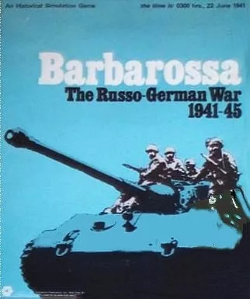
Barbarossa: The Russo-German War 1941–45 is a board wargame published by Simulations Publications Inc. (SPI) in 1969 that simulates the conflict between Germany and the Soviet Union on the Eastern Front of World War II. This was only SPI's second game produced during a preliminary round of "Test Series" games, and proved to be the most popular. Despite the title, taken from the German operational name for their initial invasion of the Soviet Union, the game covers the entire Eastern Front campaign from the German invasion in 1941 to the Fall of Berlin in 1945.

The Battles of Bull Run, subtitled "Manassas – June 1861 and August 1862", is a board wargame published by Simulations Publications Inc. (SPI) in 1972 that contains two American Civil War simulations covering the First Battle of Bull Run in 1861, and the Second Battle of Bull Run in 1862.

Lee Moves North, originally titled Lee at Gettysburg and subtitled "The Confederate Summer Offensive, 1862 & 1863", is a board wargame published by Simulations Publications Inc. (SPI) in 1972 that simulates Robert E. Lee's summer offenses of 1862 and 1863 during the American Civil War
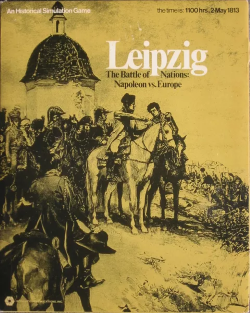
Leipzig: The Battle of Nations, subtitled "Napoleon vs. Europe", is a board wargame published by Simulations Publications Inc. (SPI) in 1969 that simulates the 1813 campaign of Napoleon in central Europe, including the Battle of Leipzig. The game was one of the first Napoleonic board wargames, and a number of innovative rules such as the effect of individual leaders on combat were adopted by other wargame publishers.
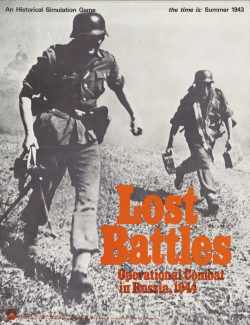
Lost Battles: Operational Combat in Russia is a board wargame published by Simulations Publications Inc. (SPI) in 1971 that simulates hypothetical combat situations set in the Soviet Union during World War II.

MechWar '77, subtitled "Tactical Armored Combat in the 1970s", is a board wargame published by Simulations Publications Inc. (SPI) in 1975 that simulates hypothetical tank combat in the mid-1970s between various adversaries, using the same rules system as the previously published Panzer '44.

The Moscow Campaign, subtitled "Strike and Counterstrike Russia", is a board wargame published by Simulations Publications Inc. (SPI) in 1972 that simulates combat near Moscow during World War II.

Year of the Rat, Vietnam, 1972 is a board wargame published by Simulations Publications Inc. (SPI) in 1972 that simulates the Easter Offensive that had just happened during the Vietnam War.

Battle of the Wilderness: Gaining the Initiative, May 5-6, 1864 is a board wargame published by Simulations Publications, Inc. (SPI) in 1975 that simulates the Battle of the Wilderness during the American Civil War. The game was originally part of the four-game collection Blue & Gray II, and was also released as a stand-alone "folio" game.

Breakout & Pursuit: The Battle for France, 1944 is a board wargame published by Simulations Publications Inc. (SPI) in 1972 that simulates the breakout of Allied forces from Normandy during World War II, and their subsequent pursuit of retreating German forces.
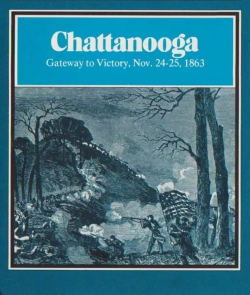
Chattanooga: Gateway to Victory, Nov. 24-25, 1863 is a board wargame published by Simulations Publications, Inc. (SPI) in 1975 that simulates the Battle of Chattanooga during the American Civil War. The game was originally part of the four-game collection Blue & Gray II, and was also released as a stand-alone "folio" game.
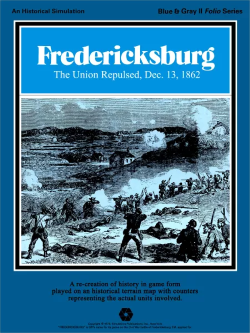
Fredericksburg: The Union Repulsed is a board wargame published by Simulations Publications, Inc. (SPI) in 1975 that simulates the Battle of Fredericksburg during the American Civil War. The game was originally part of the four-game collection Blue & Gray II, and was also released as a stand-alone "folio" game.

Turning Point: The Battle of Stalingrad is a board wargame published by Simulations Publications Inc. (SPI) in 1972 that simulates the Battle of Stalingrad during World War II, and the factors that led to the encirclement and destruction of Germany's Sixth Army.

Red Star/White Star: Tactical Combat in Europe in the 1970s is a board wargame published by Simulations Publications Inc. (SPI) at the height of the Cold War in 1972 that simulates hypothetical battles in West Germany between Warsaw Pact invaders and NATO defenders.

War Between the States 1861–1865 is a grand strategy monster board wargame published by Simulations Publications Inc. (SPI) in 1977 that simulates the American Civil War. Players can choose to play scenarios representing a single year of the war, or can play a campaign game that covers the entire war in both the Eastern and Western Theaters from the Battle of Fort Sumter to the Confederate surrender at Appomattox Court House.

The Franco-Prussian War, subtitled "August 1 to September 2, 1870", is a board wargame published by Simulations Publications Inc. (SPI) in 1972 that simulates the 1870 war between the Second French Empire and the North German Confederation led by the Kingdom of Prussia.

Rifle & Saber: Tactical Combat 1850–1900 is a board wargame published by Simulations Publiucations Inc. (SPI) in 1973 that simulates at a tactical level various battles and skirmishes from the mid-19th century to the dawn of the 20th century. Although popular for a time due to its simple rules and many scenarios, it did not receive critical acclaim, and quickly fell out of favor as better wargames appeared on the market.
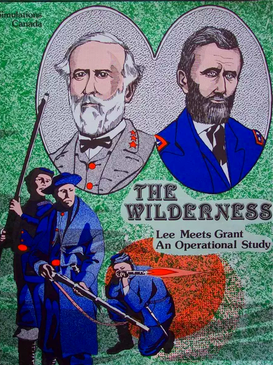
The Wilderness, subtitled "Lee Meets Grant: An Operational Study", is a board wargame published by Simulations Canada in 1983 that simulates the Battle of the Wilderness during the American Civil War.

Shenandoah, subtitled "A Civil War Game of the Valley Campaigns — 1862 and 1864", is a board wargame published by Battleline Publications in 1975 that simulates two campaigns of the American Civil War: the 1862 Valley Campaign of Confederate general Stonewall Jackson, and the 1864 Union offensive drive up the Shenandoah Valley. Despite favorable critical reception, the game was complex and introduced several new mechanics, and was not popular with players.

Rifle-Musket is a tactical board wargame published by Simulations Design Corporation (SDC) in 1974 that simulates skirmishes that occurred during the American Civil War.